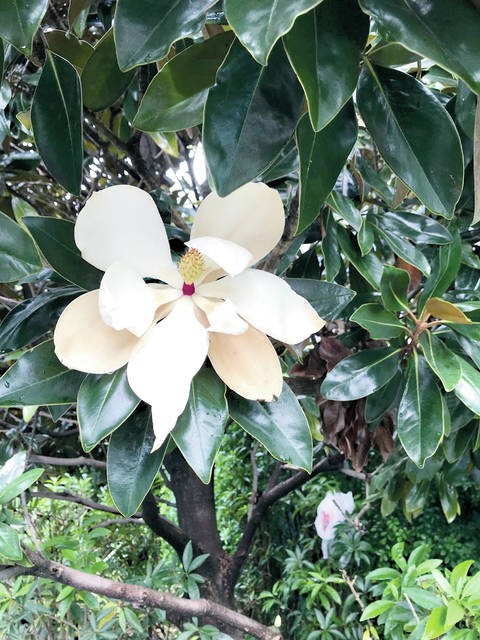Tropical Gardening: Fragrance adds another pleasure to Hawaiian gardens

Courtesy of VOLTAIRE MOISE
Hawaii is famous for its perfumed air. The lemon-scented Magnolia grandiflora is one of many fragrant flowering trees that make Hawaiian gardens special. Grafted trees stay small and flower heavily.
“April showers bring May flowers” on the mainland, but in Hawaii spring is all year.
“April showers bring May flowers” on the mainland, but in Hawaii spring is all year.
However, there is a noticeable spring fever effect when it comes to local gardeners because many flowers start heavy blooming at this time.
ADVERTISING
Have you ever noticed Hawaiian air smells better than most other places on the mainland?
Visitors and residents returning from a trip often comment about the sweet heavy fragrance the moment they step off the plane. This is especially true now as plumeria, jasmine and other flowers begin their spring bloom.
Coffee trees bloom this time of year, adding fragrance along country roads, as well as ylang-ylang (Cananga oderata), mulang (Michelia champaca), lemon-scented magnolia (Magnolia grandiflora) and many other flowering trees.
Hawaii has a special magic.
The scent of flowers perfumes the air and sets a tropical, romantic mood whether you live mauka or makai. By adding more flowering plants to your area, you can combat unpleasant smells such as car exhaust fumes or rubbish cans.
There are many good choices for your garden.
The scent of orange blossoms and, of course, grapefruit, lime, lemon and tangerine blossoms all have delicious fragrance. During the longer days of summer, many species of ginger are in full bloom and in the evening, white, yellow and rose flowered angel trumpets make for perfect garden romance.
But there are many other lesser known and more varied plants that can add to our gardens.
All the plants listed below have fragrant flowers. Some of them, such as plumeria, night blooming jasmine, fragrant dracaena, gardenia and mock orange, are equipped with fragrance so potent that it can fill every inch of garden air space and drift into the house, too. Others, such as the spider lily, produce more subtle perfumes that usually won’t travel quite as far and are best appreciated at close range.
There are dozens of species of ginger and let us not forget our native alahe‘e and hoawa available at some nurseries.
There are many kinds of jasmine as well as several other plants called by that name, including star jasmine and orange jasmine (mock orange) that are not jasmines at all. There are several true jasmines that bloom with fragrant flowers. Jasminum ilicifolium and Jasminum multifolorum are two shrubs used as foundation plantings. They also can be grown as vines and will bloom more profusely. Jasminum sambac is the one we call pikake.
Star jasmine (Trachelospermum jasminoides) is a vine. Tie this plant to a post, fence or some other support and it will climb. Pinch out the viny branch tips and it will cover the ground. The clusters of star-shaped, white flowers contrast nicely with shiny dark green leaves.
This vine is sometimes referred to as maile jasmine because the leaves resemble maile.
Mock orange (Murraya paniculata), or orange jasmine, is a member of the citrus family and is an attractive evergreen shrub or small tree with glossy green pinnately-compound leaves. The white, very fragrant flowers are produced at intervals throughout the year, followed by clusters of red ovoid fruit.
It is a vigorous grower and can be used as a small tree, an informal high hedge or screen or trimmed to a formal shape.
The ever popular plumeria should be found in most gardens, but a close relative is rare. It is known as Tabernaemontana, or cinnamon gardenia, and was originally introduced by Paul Weissich in 1960 from Africa. Flowers are produced all during the year and have a cinnamon fragrance. The odor is delicate, but one or two flowers perfume the whole garden. Close relatives are ervatamia (crepe jasmine) cerbera, stemmadenia and oleander.
Stop by your local garden shops and nurseries to find these and many others for garden fragrance.
A great reference book to help you chose plants for your garden and their care is Sunset’s “New Western Garden Book,” available at most garden shops.


